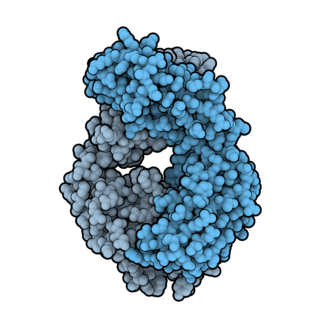
The common cold or the cold is a viral infectious disease of the upper respiratory tract that primarily affects the respiratory mucosa of the nose, throat, sinuses, and larynx. Signs and symptoms may appear fewer than two days after exposure to the virus. These may include coughing, sore throat, runny nose, sneezing, headache, and fever. People usually recover in seven to ten days, but some symptoms may last up to three weeks. Occasionally, those with other health problems may develop pneumonia.

A cough is a sudden expulsion of air through the large breathing passages which can help clear them of fluids, irritants, foreign particles and microbes. As a protective reflex, coughing can be repetitive with the cough reflex following three phases: an inhalation, a forced exhalation against a closed glottis, and a violent release of air from the lungs following opening of the glottis, usually accompanied by a distinctive sound.

Cold medicines are a group of medications taken individually or in combination as a treatment for the symptoms of the common cold and similar conditions of the upper respiratory tract. The term encompasses a broad array of drugs, including analgesics, antihistamines and decongestants, among many others. It also includes drugs which are marketed as cough suppressants or antitussives, but their effectiveness in reducing cough symptoms is unclear or minimal.

Respiratory syncytial virus (RSV), also called human respiratory syncytial virus (hRSV) and human orthopneumovirus, is a contagious virus that causes infections of the respiratory tract. It is a negative-sense, single-stranded RNA virus. Its name is derived from the large cells known as syncytia that form when infected cells fuse.

An upper respiratory tract infection (URTI) is an illness caused by an acute infection, which involves the upper respiratory tract, including the nose, sinuses, pharynx, larynx or trachea. This commonly includes nasal obstruction, sore throat, tonsillitis, pharyngitis, laryngitis, sinusitis, otitis media, and the common cold. Most infections are viral in nature, and in other instances, the cause is bacterial. URTIs can also be fungal or helminthic in origin, but these are less common.

Guaifenesin, also known as glyceryl guaiacolate, is an expectorant medication taken by mouth and marketed as an aid to eliminate sputum from the respiratory tract. Chemically, it is an ether of guaiacol and glycerine. It may be used in combination with other medications. A 2014 study found that guaifenesin has no effect on sputum production or clearance in upper respiratory infections.

Fenfluramine, sold under the brand name Fintepla, is a serotonergic medication used for the treatment of seizures associated with Dravet syndrome and Lennox–Gastaut syndrome. It was formerly used as an appetite suppressant in the treatment of obesity, but was discontinued for this use due to cardiovascular toxicity before being repurposed for new indications. Fenfluramine was used for weight loss both alone under the brand name Pondimin and in combination with phentermine.

Amoxicillin/clavulanic acid, also known as co-amoxiclav or amox-clav, sold under the brand name Augmentin, among others, is an antibiotic medication used for the treatment of a number of bacterial infections. It is a combination consisting of amoxicillin, a β-lactam antibiotic, and potassium clavulanate, a β-lactamase inhibitor. It is specifically used for otitis media, streptococcal pharyngitis, pneumonia, cellulitis, urinary tract infections, and animal bites. It is taken by mouth or by injection into a vein.

Fluticasone propionate, sold under the brand names Flovent and Flonase among others, is a steroid medication. When inhaled it is used for the long term management of asthma and COPD. In the nose it is used for hay fever and nasal polyps. It can also be used for mouth ulcers. It works by decreasing inflammation.

Dextromethorphan (DXM) is a cough suppressant used in many cough and cold medicines. It affects NMDA, and sigma-1 receptors in the brain, all of which have been implicated in the pathophysiology of depression. In 2022, the FDA approved a formulation of it combined with bupropion named Auvelity to serve as a rapid acting antidepressant in patients with major depressive disorder.
Mucoactive agents are a class of chemical agents that aid in the clearance of mucus or sputum from the upper and lower airways, including the lungs, bronchi, and trachea. Mucoactive drugs include expectorants, mucolytics, mucoregulators, and mucokinetics. These medications are used in the treatment of respiratory diseases that are complicated by the oversecretion or inspissation of mucus. These drugs can be further categorized by their mechanism of action.

Pentoxyverine (rINN) or carbetapentane is an antitussive commonly used for cough associated with illnesses like common cold. It is sold over-the-counter as Solotuss, or in combination with other medications, especially decongestants. One such product is Certuss, a combination of guaifenesin and pentoxyverine. The drug has been available in the form of drops, suspensions and suppositories.

Ofatumumab is a fully human monoclonal antibody to CD20, which appears to provide rapid B-cell depletion. Under the brand name Kesimpta, it is approved for the treatment of multiple sclerosis in the United States as well as in the European Union and other regions. Under the brand name Arzerra, it is approved for the treatment of certain types of chronic lymphocytic leukemia (CLL) in the United States. It is sold by Novartis under license from Genmab.
A postinfectious cough is a lingering cough that follows a respiratory tract infection, such as a common cold or flu and lasting up to eight weeks. Postinfectious cough is a clinically recognized condition represented within the medical literature. Patients usually experience repeated episodes of postinfectious cough. The heightened sensitivity in the respiratory tract is demonstrated by inhalation cough challenge.

Dropropizine is a cough suppressant that is sold in Germany, Central America, South America, and some African countries such as Congo. It is sold as suppositories, tablets, and syrup. It is used to stop a cough caused by allergies or a cold.

Oxeladin is a cough suppressant. It is a highly potent and effective drug used to treat all types of cough of various etiologies. It is not related to opium or its derivatives, so treatment with oxeladin is free of risk of dependence or addiction. Oxeladin has none of the side effects which are present when common antitussives, such as codeine and its derivatives, are used. It may be used at every age, as well as in patients with heart disease, since it has a high level of safety and a great selectivity to act on the bulbar centre of cough.

Caramiphen is an anticholinergic drug used in the treatment of Parkinson's disease. In combination with phenylpropanolamine it is used as a cough suppressant and nasal decongestant to treat symptoms associated with respiratory illnesses such as cold, allergies, hay fever, and sinusitis. It was added to the British National Formulary in 1963, with a dosage of 10 to 20 mg. Side effects include nausea, dizziness, and drowsiness.

Umeclidinium bromide/vilanterol, sold under the brand name Anoro Ellipta, among others, is a fixed-dose combination medication for the treatment of chronic obstructive pulmonary disease (COPD). It is administered by inhalation.
Sutimlimab, sold under the brand name Enjaymo, is a monoclonal antibody that is used to treat adults with cold agglutinin disease (CAD). It is given by intravenous infusion. Sutimlimab prevents complement-enhanced activation of autoimmune human B cells in vitro.
Budesonide/glycopyrronium bromide/formoterol, sold under the brand name Breztri Aerosphere among others, is an inhalable fixed-dose combination medication for the treatment of chronic obstructive pulmonary disease (COPD). It contains budesonide, glycopyrronium bromide, and formoterol fumarate dihydrate. It is inhaled.
















